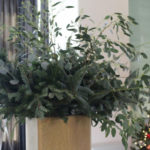This first appeared as “EHC Corner: Holiday Greenery” in the IR-4 Newsletter 49(4):13.
Plant Information
 The smell of cedar, pine and other evergreens are synonymous with the winter holidays. Whether wreaths or boughs hung inside or out, this greenery visually signals the start of the US holiday season and its aroma brings back childhood memories of home. The tradition of using evergreen plants to decorate in the winter originated thousands of years ago within many cultures celebrating the winter solstice: Egyptians celebrating the return of Ra, Celtic druids symbolizing eternal rebirth, Romans desiring a good harvest year at the feast of Saturnalia (Saturn, the god of agriculture), and Vikings warding off evils spirits.
The smell of cedar, pine and other evergreens are synonymous with the winter holidays. Whether wreaths or boughs hung inside or out, this greenery visually signals the start of the US holiday season and its aroma brings back childhood memories of home. The tradition of using evergreen plants to decorate in the winter originated thousands of years ago within many cultures celebrating the winter solstice: Egyptians celebrating the return of Ra, Celtic druids symbolizing eternal rebirth, Romans desiring a good harvest year at the feast of Saturnalia (Saturn, the god of agriculture), and Vikings warding off evils spirits.
Some of the traditional evergreens (fir, hemlock, holly, juniper, mistletoe, pine, spruce) have been joined by arborvitae, cypress, eucalyptus, mountain pepper, podocarpus, rosemary and others. Any plants with evergreen foliage that can provide interesting colors and textures can be incorporated into wreaths, boughs, and other displays.
Sources of these evergreens are varied. The vast majority come from trimmings from public and private forestlands and Christmas tree producers. For example, trees produced for wood often have side branches removed to limit the formation of knots. Other sources include prunings from nursery producers or in the case of eucalyptus deliberate production of cuts for floral displays year-round.
Main Disease Problems
Each of the different crop species have different disease complexes. The conifers tend to have similar root problems (Pythium, Phytophthora, Rhizoctonia, Fusarium, Cylindrocladium) as other crops, but they also have some unique ones Rhizosphaera Needle Cast (multiple), Cytospora canker (spruce), Cedar Apple rust (juniper), Phomopsis tip blight (juniper), Diplodia tip blight (pines and others). Boxwood is affected by boxwood blight, volutella blight, Macrophoma leaf spot, Fusarium, Phytophthora, and nematodes.
Main Pest Problems
Each of the different crop species have different pest complexes. Generally, they are impacted by adelgids (Hemlock Woolly Adelgid), aphids, bagworms, borers and beetles (Emerald Ash Borer, Southern Pine Beetle), sawflies, and scale (Juniper Scale). Boxwood is affected by leafminer, psyllid, mites and several other less impactful pests.
IR-4 Research
IR-4 has studied several diseases and pests of conifers since 2000: Elongate Hemlock Scale, Phytophthora ramorum, Phytophthora cinnamomi, Phytophtora cryptogea, Oriental Beetle, Black Vine Weevil, Pine Needle Scale, Botrytis Gary Mold, Fusarium commune, Tarnished Plant Bugs, Swiss Needle Cast, Pythium dissotocum, Pythium irregulare, Pythium ultimum, Pythium vipa, Fletcher Scale. In addition, IR-4 has sponsored more than 850 conifer crop safety trials on 81 products. IR-4 also worked with a team of researchers investigating Boxwood Blight.
Sources Cited
https://growbeautifully.monrovia.com/growing-greenery-for-holiday-decorating/
https://en.wikipedia.org/wiki/Wreath
Gary W. Knox, Timur Momol, Russell F. Mizell, III, AND Hank Dankers. 2003. Crop Timeline for Nursery-Grown Evergreens and Shade Trees
http://www.livingthecountrylife.com/gardening/history-of-holiday-greenery/
https://www.knowyourforest.org/sites/default/files/documents/Evergreen_boughs.pdf
https://hort.uwex.edu/articles/conifer-disease-quick-reference/
http://ccesuffolk.org/resources/photographic-guide-of-boxwood-pests-diseases-on-long-island


